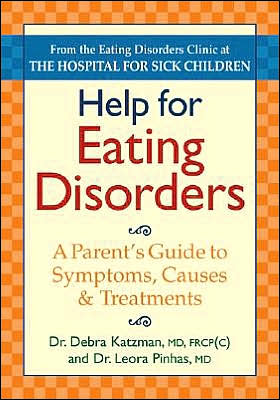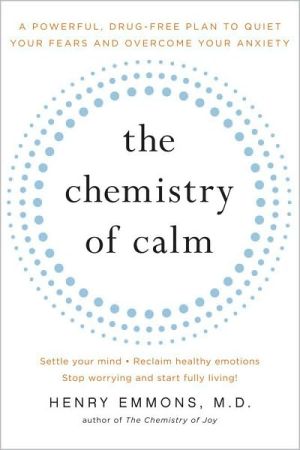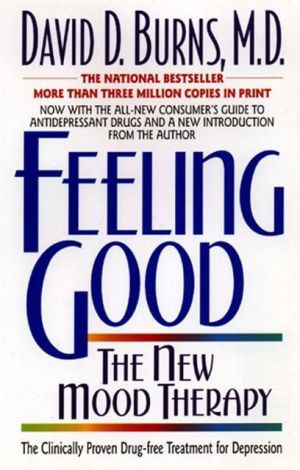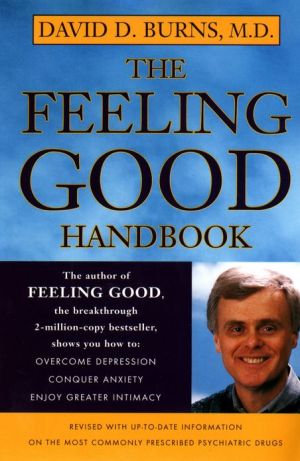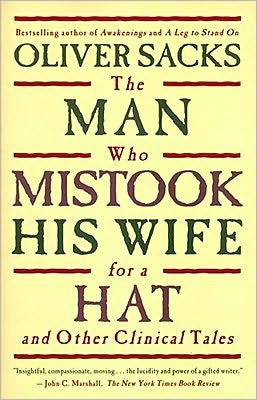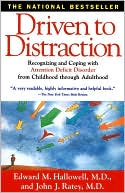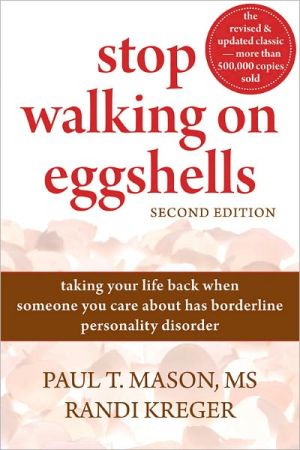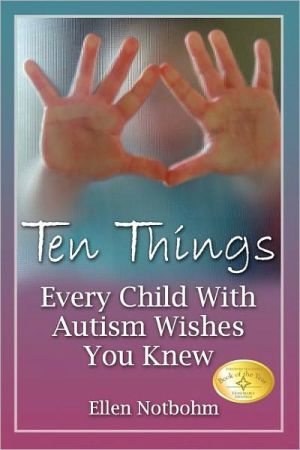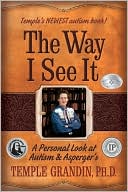Help for Eating Disorders: A Parent's Guide to Symptoms, Causes and Treatment
Straightforward solutions to difficult problems.\ Most teenagers have a friend who has been affected by an eating disorder. Such disorders affect almost 20% of teenage girls in North America at some point in their development.\ Magazines and movies constantly stress a thin body image as the defining force for popularity. The message teenagers get is that thin is the only route to popularity and happiness.\ Through the Eating Disorder Program, Drs. Katzman and Pinhas, at The Hospital for Sick...
Search in google:
A guide based on The Eating Disorder Program at The Hospital for Sick Children (Toronto) helps parents identify if their child has a problem, plan for their recovery, and get support. Includes workbooks, diaries and case studies. Doody Review Services Reviewer:Amer Smajkic, MD(Rush University Medical Center)Description:This book describes diagnosis and treatment of, and recovery from, eating disorders. It offers a basic understanding of eating disorders, specifics on how they affect children and adolescents, how to recognize if they need help, how to perceive the assessment and treatment of children with eating disorders, and what to expect from recovery and treatment.Purpose:The purpose is to provide a detailed book that organizes clinical knowledge and personal experience about all the major areas of eating disorders. The book is organized into three parts including diagnosis, treatment, and family and community roles in recovery and prevention.Audience:The targeted audiences are mainly parents and families, but professionals whose daily life involves working with children and adolescents with eating disorders could also benefit.Features:The book outlines description, myths, misconceptions, risk factors, causes, how to identify and how to recognize complications related to eating disorders. It describes care and treatment, focusing on treatment resources in the community, getting assessment, choosing a treatment strategy, learning to eat again, coping with relapses, and making the transition from adolescent to adult. Information about focusing on roles of family and community in recovery and prevention of eating disorders detail how to help yourself and your child, how to look for resources in social networks, how to educate professionals working with your child, and what to expect from recovery are included. The text is strengthened with tables, handy explanations, tips, and valuable cases with two personal testimonials written by a parent and by a young person with anorexia. References are up to date.Assessment:This is a good functional book targeting parents, but also useful to professionals and clinicians. It is written in clear and structured manner. The book does highlight all the important issues in the area of eating disorders.
Preface\ PART 1 Diagnosing Eating Disorders\ Chapter 01: What Is an Eating Disorder?\ Chapter 02: What Are the Myths and Misconceptions about Eating Disorders?\ Chapter 03: Who Is at Risk for Developing an Eating Disorder?\ Chapter 04: What Factors Cause the Increasing Prevalence of Eating Disorders?\ Chapter 05: What Is Normal Adolescent Development?\ Chapter 06: How Do You Identify a Child or Adolescent with an Eating Disorder?\ Chapter 07: What Are the Possible Medical Complications of Eating Disorders?\ Chapter 08: What Is My Child Thinking?\ How Could This Have Happened to Our Family? A Mother's Story\ PART 2 Treating Eating Disorders\ Chapter 09: Charting the Road to Recovery Chapter 10: Exploring Treatment Resources in Your Community\ Chapter 11: Getting an Assessment Chapter 12: Choosing a Treatment Strategy Chapter 13: Learning to Eat Again Chapter 14: Coping with Lapses and Relapses Chapter 15: Making the Transition from the Adolescent to the Adult Treatment System\ The Struggle of My Life A Patient's Story\ PART 3 Family and Community Roles in Recovery and Prevention\ Chapter 16: Everyone Needs Help Chapter 17: Helping Yourself to Help Your Child Chapter 18: Looking for Help from Friends Chapter 19: Preventing Eating Disorders by Educating Teachers, Coaches, and Counselors Chapter 20 Understanding the Long and Hard Journey to Recovery\ Eating Disorder Information Resources References Acknowledgments Index\ ------\ \ Contributors\ PART 1 Diagnosing Eating Disorders\ What Is an Eating Disorder?\ Debra K. Katzman, MD, FRCP(C), and Leora Pinhas, MD, FRCP(C)\ What Are the Myths and Misconceptions about Eating Disorders?\ Abmed Boachie, MB, ChB, MRC Psych, DCH, FRCP(C), and Karin Jasper, PhD, MEd\ Who Is at Risk for Developing an Eating Disorder?\ Debra K. Katzman, MD FRCP(C), and Lily Cugliari-Kobayashi, RN, PCN/NP, HTCP (Level III)\ What Factors Cause the Increasing Prevalence of Eating Disorders?\ Karin Jasper, PhD, Med, and Ahmed Boachie, MB, ChB, MRCPsych, DCH, FRCP(C)\ What Is Normal Adolescent Development?\ Eudice Goldberg, MD, FRCP(C), Gad Reisler, MD, and Nogah Kerem, MD\ How Do You Identify a Child or Adolescent with an Eating Disorder?\ Karen Leslie,\ MD, FRCP(C), and Anganette Hall, MBChB, DCH\ What Are the Possible Medical Complications of Eating Disorders?\ Natasha Johnson-Ramgeet, MD, FRCP(C)\ What Is My Child Thinking?\ Clare Roscoe, MD, FRCP(C)\ How Could This Have Happened to Our Family? -- A Mother's Story Susan Bauman-Fenicky\ PART 2 Treating Eating Disorders\ Charting the Road to Recovery Margus Heinmaa, MPsy, PhD Candidate\ Getting an Assessment Patti Schabas, MD, FRCP(C)\ Choosing a Treatment Strategy Pier Bryden, M.Phil, MD, FRCP(C)\ Learning to Eat Again Kelly Sherwood, RD, Tania Turrini, RD, and Kellie Welch, RD\ Coping with Lapses and Relapses Caitlin Shipley, MSW~ RSW\ Making the Transition from the Adolescent to the Adult Treatment System Blake Woodside, MD, and Gina Dimitropoulos, MSW, RSW, PhD Candidate\ The Struggle of My Life -- A Patient's Story Tammy BaJa ban\ PART 3 Family and Community Roles in Recovery and Prevention\ Everyone Needs Help Geordie Colvin, MSW~ RSW\ Helping Yourself to Help Your Child Sheila Bjarnason, MSW~ RSW\ Looking for Help from Friends Elise Byer, MSW RSW\ Preventing Eating Disorders by Educating Teachers, Coaches, and Counselors Gail MeVey, PhD, C Psych\ Understanding the Long and Hard Journey to Recovery Max Figueroa, MD and Debra K. Katzman, MD, FRCP(CJ\ Eating Disorder Information Resources Debra K. Katzman, MD, FRCP(C), and Leora Pinhas, MD, FRCP(C)
\ From The CriticsReviewer: Amer Smajkic, MD(Rush University Medical Center)\ Description: This book describes diagnosis and treatment of, and recovery from, eating disorders. It offers a basic understanding of eating disorders, specifics on how they affect children and adolescents, how to recognize if they need help, how to perceive the assessment and treatment of children with eating disorders, and what to expect from recovery and treatment.\ Purpose: The purpose is to provide a detailed book that organizes clinical knowledge and personal experience about all the major areas of eating disorders. The book is organized into three parts including diagnosis, treatment, and family and community roles in recovery and prevention.\ Audience: The targeted audiences are mainly parents and families, but professionals whose daily life involves working with children and adolescents with eating disorders could also benefit.\ Features: The book outlines description, myths, misconceptions, risk factors, causes, how to identify and how to recognize complications related to eating disorders. It describes care and treatment, focusing on treatment resources in the community, getting assessment, choosing a treatment strategy, learning to eat again, coping with relapses, and making the transition from adolescent to adult. Information about focusing on roles of family and community in recovery and prevention of eating disorders detail how to help yourself and your child, how to look for resources in social networks, how to educate professionals working with your child, and what to expect from recovery are included. The text is strengthened with tables, handy explanations, tips, and valuable cases with two personal testimonials written by a parent and by a young person with anorexia. References are up to date.\ Assessment: "This is a good functional book targeting parents, but also useful to professionals and clinicians. It is written in clear and structured manner. The book does highlight all the important issues in the area of eating disorders. "\ \ \ \ \ Journal of the National Medication AssociationMagnificent realistic advice to those who care for and about a child with an eating disorder... The book is highly recommended -- accolades and applause to the authors for responsibly educating the public about eating disorders.\ \ \
